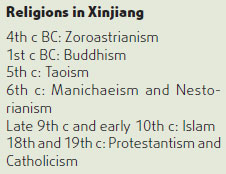Around the 6th century, Manichaeism reached Xinjiang from Persia. In the middle of the 9th century, when the Uygur, who were believers in Manichaeism, moved west to Xinjiang, they promoted the development of the religion in the region. They built temples, dug grottoes, translated scriptures, painted frescoes and spread the Manichaeist creed and culture in the Turpan area.
Around the same time, Nestorianism, an earlier sect of Christianity, was introduced into Xinjiang, but it was not widespread in the early years. It flourished only when large numbers of the Uygur accepted it during the Yuan Dynasty (1206-1368).
In the late 9th century and the early 10th century, Islam spread to the south of Xinjiang through Central Asia. In the middle of the 10th century, the Islamic Karahan Kingdom waged a religious war against the Buddhist kingdom of Yutian, which lasted for more than 40 years. It conquered Yutian in the early 11th century, and introduced Islam to Hotan.

In the middle of the 14th century, under the coercion of the Qagatay Khanate (a subservient state created by Qagatay, the second son of Genghis Khan), Islam gradually became the main religion for the Mongolian, Uygur, Kazak, Kirgiz and Tajik people in that region.
In the early 16th century, Islam finally became the main religion in Xinjiang, replacing Buddhism. After that, Zoroastrianism, Manichaeism and Nestorianism, the main religions of the Uygur and other ethnic groups, gradually disappeared in Xinjiang, but Buddhism and Taoism continued to make themselves felt.
Beginning in the Ming Dynasty (1368-1644), Tibetan Buddhism grew in Xinjiang into a major religion on a par with Islam. In the late 17th century, Apak Hoja, chief of the Aktaglik sect of Islam, wiped out the forces of his political enemy Hoja of the Karataglik sect, by dint of Tibetan Buddhist forces, and destroyed the Yarkant Khanate (a regional regime established by Qagatay's descendants between 1514 and 1680, with modern Shache as its center). This shows how powerful Tibetan Buddhism was at that time.
Around the 18th and 19th centuries, Protestantism and Catholicism spread to Xinjiang, their followers being mainly among the Han people.
Historically, the dominance of a particular religion has kept changing from time to time in Xinjiang, but the coexistence of multiple religions following the introduction of outside religious faiths has never changed. The major religions in Xinjiang today are Islam, Buddhism (including Tibetan Buddhism), Protestantism, Catholicism and Taoism. Shamanism still has considerable influence among some ethnic groups.
(China Daily March 10, 2009)